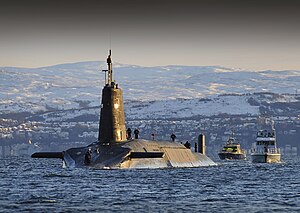
Back Vanguard-klas duikboot Afrikaans غواصة فانغارد Arabic Třída Vanguard Czech Vanguard-klassen Danish Vanguard-Klasse (1992) German Clase Vanguard Spanish زیردریایی کلاس ونگارد Persian Vanguard-luokka (sukellusvene) Finnish Classe Vanguard French הצוללות מסדרת ואנגארד HE
 HMS Vanguard at Faslane, 2010
| |
| Class overview | |
|---|---|
| Builders | Vickers Shipbuilding and Engineering, Barrow-in-Furness, England |
| Operators | |
| Preceded by | Resolution class |
| Succeeded by | Dreadnought class |
| Cost | |
| Built | 1986–1998 |
| In service | 1993–present |
| Completed | 4 |
| Active | 4 |
| General characteristics | |
| Type | Nuclear-powered ballistic missile submarine |
| Displacement | Submerged: 15,900 t (15,600 long tons; 17,500 short tons) |
| Length | 149.9 m (491 ft 10 in) |
| Beam | 12.8 m (42 ft 0 in) |
| Draught | 12 m (39 ft 4 in) |
| Propulsion |
|
| Speed | Over 25 knots (46 km/h; 29 mph), submerged |
| Range | Limited only by food and mechanical components |
| Complement | 135 |
| Sensors and processing systems |
|
| Electronic warfare & decoys |
|
| Armament |
|
The Vanguard class is a class of nuclear-powered ballistic missile submarines (SSBNs) in service with the Royal Navy.[2] The class was introduced in 1994 as part of the Trident nuclear programme, and comprises four vessels: Vanguard, Victorious, Vigilant and Vengeance, built between 1986 and 1999 at Barrow-in-Furness by Vickers Shipbuilding and Engineering, now owned by BAE Systems.[3] All four boats are based at HM Naval Base Clyde (HMS Neptune), 40 km (25 mi) west of Glasgow, Scotland.
Since the decommissioning of the Royal Air Force WE.177 free-fall thermonuclear weapons during March 1998, the four Vanguard submarines are the sole platforms for the United Kingdom's nuclear weapons.[4] Each submarine is armed with up to 16 UGM-133 Trident II missiles. The class is scheduled to be replaced starting in the early 2030s with the Dreadnought-class submarine.[5][6]
- ^ Hartley (PDF) Archived 17 March 2012 at the Wayback Machine nuclearinfo.org
- ^ Royal Navy Vanguard class submarine, royalnavy.mod.uk
- ^ Jane's Fighting Ships, 2004–2005. Jane's Information Group Limited. p. 794. ISBN 0-7106-2623-1.
- ^ Strategic Defence Review White Paper of July 1998, published by National Archives – re-access made 2020-03-09
- ^ "Everything you need to know about Trident – Britain's nuclear deterrent". ITV News. ITV plc. 18 July 2016. Retrieved 20 July 2016.
The £40 billion construction of a new fleet, Successor, could begin this year and be operational by 2028, however it will more than likely be at a later date given the MoD's complex procurement procedures. while the current fleet will be phased out by 2032.
- ^ "BAE Systems to begin building new British nuclear submarines". Reuters. 1 October 2016. Retrieved 1 October 2016.
© MMXXIII Rich X Search. We shall prevail. All rights reserved. Rich X Search